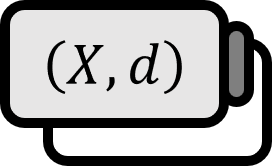The Importance of Compactness Conditions in Metric Spaces
Overview
Many theorems in analysis require compactness as a necessary condition (Reference1, Reference2, Reference3, Reference4). While it’s taken for granted that ‘if it’s compact, then it’s fine’ due to the assumption of compactness in the proof process, one might wonder why ‘if it’s not compact, then it’s not fine’. If the condition of being compact is absent, the following undesirable situations can occur.
Theorem1
Let’s say $E\subset \mathbb{R}$ is a non-compact set. Then,
(a) There exists a continuous function defined above $E$ that is not bounded.
(b) There exists a continuous and bounded function defined above $E$ that does not have a maximum value.
(c) Now let’s assume the condition that $E$ is bounded. Then, there exists a continuous function defined above $E$ that is not uniformly continuous.
(a), (b), (c) demonstrate that the condition of being compact is necessary for the respective theorems ‘A continuous function in a compact metric space is bounded’, ‘Extreme Value Theorem’, ‘A continuous function in a compact metric space is uniformly continuous’ to hold.
Proof
(c)
The equivalent condition for compactness in $\mathbb{R}$ is being closed and bounded. So, let’s assume that $E$ is just bounded. Then, since it’s not closed, there exists a limit point of $E$ that is not included in $E$, let’s call this point $x_{0}$. Now, consider the following function.
$$ f(x)=\frac{1}{x-x_{0}}\quad (x \in E) $$
Since both the numerator and the denominator are continuous functions, $f$ is also a continuous function in $E$. Clearly, $f$ is not bounded. Furthermore, now consider $x \in E$ that satisfies the following equation for arbitrary two positive numbers $\varepsilon$ and $\delta$.
$$ \left|x-x_{0} \right|< \delta \implies \left|f(x)-f(x_{0}) \right|<\varepsilon $$
However, by choosing $t$ sufficiently close to $x_{0}$, the difference in function values can be made larger than $\varepsilon$ as follows.
$$ \left|t-x_{0} \right|<\delta \implies \left|f(t)-f(x_{0}) \right|>\varepsilon $$
Therefore, $f$ is not uniformly continuous.
■
(a)
Bringing the same notation used above, consider the following function.
$$ g(x)=\frac{1}{1+(x-x_{0})^{2}}\quad (x\in E) $$
Then, $g$ is still continuous in $E$, and since $0<g(x)<1$, it is bounded. However,
$$ \sup \limits_{x\in E}g(x)=1 $$
and since $g(x)<1$, $g$ cannot have a maximum value in $E$. Therefore, we can see that just the condition of being bounded is insufficient for $E$. This was demonstrated in the condition where $E$ is bounded. Assume $E$ is not even bounded. Then,
$$ f(x)=x $$
is a function that is continuous but not bounded.
■
(b)
Consider the following.
$$ h(x)=\frac{x^{2}}{1+x^{2}} \quad (x\in E) $$
Then, it’s continuous in $E$.
$$ \sup \limits_{x\in E}h(x)=1 $$
Since for all $x\in E$, $h(x) <1$, $h$ is a continuous and bounded function but does not have a maximum value.
■
Walter Rudin, Principles of Mathmatical Analysis (3rd Edition, 1976), p91-92 ↩︎
